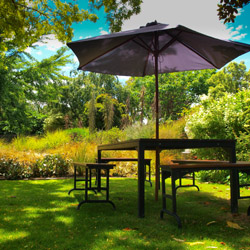Cool season turf grasses prefer to grow in the sun. To establish a thick, healthy lawn of Kentucky bluegrass and perennial rye, you will need at least six hours of full sun daily. Fine and tall fescues are more shade-tolerant and require a minimum of four hours of full or eight hours of filtered sun a day. When plants do not receive enough sun, they cannot manufacture food (photosynthesis) effectively to support growth. As a result, plants that do not receive adequate sun are less heat- and cold-tolerant and more susceptible to disease and insect damage. When it is a tree or shrub that is causing the shade, there is also competition for soil nutrients and water.
What does this mean for those of us with less than optimal light on our lawns? If it is grass that you wish to grow, it is not impossible, but you will have to settle for thinner turf. It doesn’t have to be any less healthy or hardy, however. Your chances of maintaining a healthy, thin lawn in a shady area is increased when adopting the following guidelines:
- Increase the amount of light and air circulation, if possible, by thinning tree canopies or removing the trees altogether.
- Test your soil pH. It should read between 6.0-6.5 for growing fine fescue grasses.
- If drainage is poor, improve it. Most turf grasses prefer well-drained soil.
- Use a shady grass seed mixture with a high percentage of fine fescue grasses.
- Do not sod. Most sod on the market is Kentucky bluegrass, which requires full sun.
- Sow seed in late August to avoid heat and drought stress, weed competition and suffocation from falling leaves. Early spring is the second best time to seed.
- During periods of drought, provide deep soakings to encourage a deep root system. Water early in the day to allow leaf blades a chance to dry and therefore reducing the possibility of disease.
- Mow grass high, 3-4 inches. More leaf surface is required to increase photosynthesis in the shade.
- Limit foot traffic in shady areas. This grass is already growing under stressful conditions and high use will contribute to its decline.
- Fescue requires less nitrogen than other grasses. You may allow the grass clippings to stay in place. As they break down they will provide nitrogen to the soil. A spring and fall application of a high phosphorus fertilizer should also be used.
It is highly unlikely that you will have success when attempting to grow lawn in deep or heavy shade. The one exception is Poa trivialis, commonly known as rough bluegrass. This type of lawn is very shade-tolerant, but must have consistently moist soil. Without both heavy shade and constant moisture, you will not be able to grow a rough bluegrass lawn.
Turf Alternatives
Alternatives to turf in a shady area include:
- Shade-Tolerant Evergreen Ground Covers
Though not quite the same as grass, these groundcovers provide a green landscape without needing plentiful sunlight. They can also be lower maintenance and don’t require mowing. Selections include common periwinkle, pachysandra, purple wintercreeper, English ivy and lilyturf.
- Perennial / Annual Shade Garden
Why not remove turf entirely in favor of other shade-loving plants? There are plenty of stunning perennials and annuals that don’t mind a bit of darkness. Visit our garden center and speak with our knowledgeable staff. We have an extensive selection of shade plants available and can help you make choices that will best suit your landscape conditions.
- Mulch
Mulch is an excellent turf alternative for shady areas especially under a shallow-rooted tree where it can be difficult to grow anything. Mulch can also help you define paths to walk through the shade garden and will prevent mud from becoming a problem on those paths. You can opt for wood nuggets, shredded bark, gravel, river rock or even artificial mulches in a variety of colors.
It can be a challenge to grow grass in the shade, but if you choose the proper type of grass and care for it well, you can cultivate shade-loving turf. If you’d rather not fuss with it, there are plenty of amazing alternatives that can make even the darkest corner of your landscape shine more brightly.


 Click here to stay informed
Click here to stay informed
